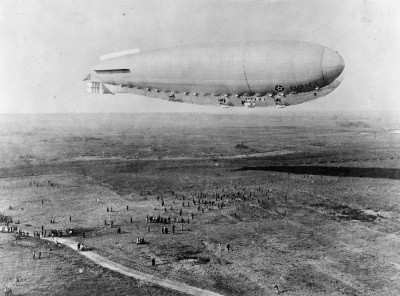Abraham Lincoln Was First President To Get A Balloon
Demonstration
The intelligence, surveillance and reconnaissance support
critical to operations in Afghanistan got its start 150 years ago
in June, when a balloonist showed then-President Abraham Lincoln
how a gas-filled balloon could help the Union Army prevail in the
Civil War. Thaddeus Lowe met with President Lincoln June 11, 1861,
to pitch the concept of balloon reconnaissance.

Civil War Balloon Demo
The idea wasn't totally new, explained Tom Crouch, the curator
for lighter-than-air aircraft at the Smithsonian's National Air and
Space Museum here. The French first used balloons in 1794 to
observe Dutch and French movements during the Battle of Fleurus.
Mr. Lowe got his chance to show President Lincoln the balloon's ISR
capabilities as he reported his sightings from a tethered balloon
as it floated 500 feet over Washington. Mr. Lowe took a telegrapher
and a lightweight telegraph set with him in the balloon's basket,
and he delivered reports to the White House via the War Department,
Mr. Crouch said.
"He could see 25 miles in every direction, and was able to
report on what he was seeing in the military camps below," Mr.
Crouch said. "He demonstrated the fact that if you could get above
the battlefield, you could see a lot of useful things, (such as)
where the enemy was and what the enemy was doing. Obviously, that
was incredibly useful information."
Convinced that balloons could provide a critical advantage on
the battlefield, President Lincoln gave the War Department the
go-ahead to establish the Union Balloon Corps. It stood up four
months later, providing the U.S' first "air force" and delivering
the nation's first aerial reconnaissance capability, Mr. Crouch
said. "Some of the most important generals of the war loved the
balloons and appreciated their value in what they could deliver,"
he said. "They found it genuinely useful in supporting what they
were doing."
But the Balloon Corps was disbanded in 1863, as the victim of
bureaucracy as well as logistics. It was run by a civilian
organization that wasn't able to work smoothly with the Army.
Further complicating things was the fact that the balloons required
extensive logistical support to move and inflate, and an entire
company of Soldiers to operate. Another challenge was to get the
intelligence collected from the balloons to the ground troops who
needed it as quickly as possible.

Air Force Museum Photo ROMA Airship First
Flight
But after the demise of the Balloon Corps, balloon
reconnaissance began to flourish in Europe, Mr. Crouch said. And
150 years later, in an age of supersonic aircraft and satellites,
Mr. Crouch said balloons continue to provide critical intelligence,
reconnaissance and surveillance in ongoing military operations. Now
unmanned, they're equipped with cameras, electronic sensors and
communication equipment to gather intelligence and provide
communications links.
Ashton B. Carter, the undersecretary of defense for acquisition,
technology and logistics, has worked to provide more of this
capability to ground forces in Afghanistan. This spring, he
announced plans to increase the number of aerostats to support
counterinsurgency operations and provide increased force
protection. "We are going to be, this summer, increasing many-fold
the number of aerostat-borne cameras," he said. "They're
terrific.
"Balloons are still with us, still providing reconnaissance for
warfighters," Mr. Crouch said. "One hundred and fifty years later,
balloons are still performing the function they did in 1861."
The Smithsonian National Air and Space Museum will mark the
150th anniversary of Mr. Lowe's demonstration and the birth of the
Union Balloon Corps June 11 on the National Mall. Reenactors will
portray Mr. Lowe, President Lincoln and Union soldiers as they
demonstrate a 19,000-cubic-foot netted gas balloon, built in 1941
to closely replicate Mr. Lowe's, officials said.
The Air and Space Museum also will give presentations about
ballooning and espionage during the Civil War and give visitors
hands-on educational activities inside the museum.
 ANN's Daily Aero-Linx (04.16.24)
ANN's Daily Aero-Linx (04.16.24) Aero-News: Quote of the Day (04.16.24)
Aero-News: Quote of the Day (04.16.24) Airborne 04.10.24: SnF24!, A50 Heritage Reveal, HeliCycle!, Montaer MC-01
Airborne 04.10.24: SnF24!, A50 Heritage Reveal, HeliCycle!, Montaer MC-01 Airborne 04.12.24: SnF24!, G100UL Is Here, Holy Micro, Plane Tags
Airborne 04.12.24: SnF24!, G100UL Is Here, Holy Micro, Plane Tags Airborne-Flight Training 04.17.24: Feds Need Controllers, Spirit Delay, Redbird
Airborne-Flight Training 04.17.24: Feds Need Controllers, Spirit Delay, Redbird




